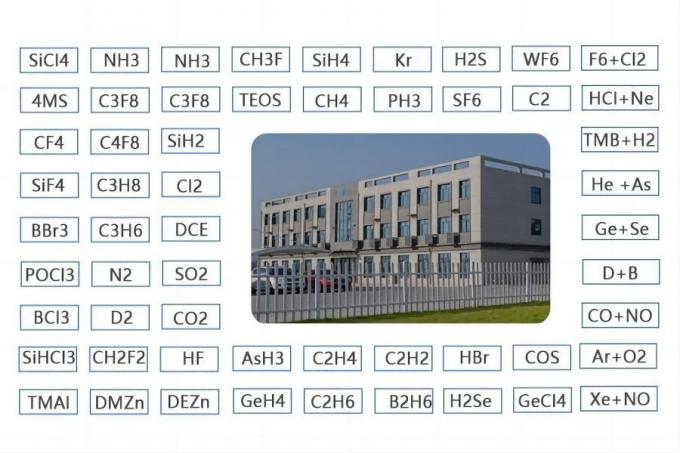


| MOQ: | 1kg |
| Price: | US $15/kg |
| Standard Packaging: | Cylinder/Tank |
| Delivery Period: | 15 days |
| Payment Method: | L/C, T/T |
| Supply Capacity: | 20000 Tons/Year |
Anhydrous hydrogen chloride (HCl) refers to hydrogen chloride gas that is free of water or moisture. Here are some key points about anhydrous hydrogen chloride:
Composition: Anhydrous hydrogen chloride is a gas composed of hydrogen (H) and chlorine (Cl) atoms. It is the gaseous form of hydrogen chloride, which is typically a liquid when in contact with water.
Production: Anhydrous hydrogen chloride can be produced by removing water from hydrogen chloride gas. This is typically done through a drying process using various methods, such as passing the gas over drying agents like calcium chloride or sulfuric acid.
Properties: Anhydrous hydrogen chloride is a colorless gas with a strong, pungent odor. It is highly soluble in water, and when exposed to moisture, it readily reacts with water to form hydrochloric acid (HCl) solution. It is corrosive and can cause severe burns to the skin, eyes, and respiratory system.
Uses: Anhydrous hydrogen chloride has various industrial applications:
Chemical Synthesis: It is used as a reactant or catalyst in various chemical reactions, including the production of dyes, plastics, pharmaceuticals, and synthetic rubber.
Semiconductor Industry: Anhydrous hydrogen chloride is utilized in the semiconductor industry for etching and cleaning silicon wafers during the manufacturing process.
Organic Synthesis: It is used for the synthesis of organic compounds, such as alkyl chlorides, chloroform, and vinyl chloride.
pH Control: Anhydrous hydrogen chloride is employed for pH adjustment in industrial processes, water treatment, and laboratory applications.
Safety Considerations: Anhydrous hydrogen chloride is highly corrosive and poses significant health hazards. It can cause severe burns, eye damage, and respiratory distress upon contact or inhalation. It is important to handle anhydrous hydrogen chloride with extreme caution, ensuring proper safety measures, including the use of suitable protective equipment, ventilation, and safe handling procedures. Storage and transportation should adhere to strict safety protocols and regulations.
It's crucial to note that anhydrous hydrogen chloride should only be handled by trained personnel in appropriate facilities equipped with the necessary safety measures to mitigate the risks associated with its use.
Specification:
| Molecular Weight | 36.46 | Density | 1.477Kg/m³ |
| Melting Point | -114.2ºC | Boiling Point | -85.1ºC |
| Appearance | Colorless,Pungent | Un No. | 1050 |
| DOT Class | 2.3&8 | Valve | CGA660 |
| Cylinder Standard | GB/ISO/DOT | Cylinder Pressure | 15Mpa/20Mpa |
| Transport Package | 44L | Specification | 99.9% |
| Trademark | CMC | Origin | China |
| HS Code | 28061000 | Production Capacity | 2000tons/Year |
Detailed Photos








| MOQ: | 1kg |
| Price: | US $15/kg |
| Standard Packaging: | Cylinder/Tank |
| Delivery Period: | 15 days |
| Payment Method: | L/C, T/T |
| Supply Capacity: | 20000 Tons/Year |
Anhydrous hydrogen chloride (HCl) refers to hydrogen chloride gas that is free of water or moisture. Here are some key points about anhydrous hydrogen chloride:
Composition: Anhydrous hydrogen chloride is a gas composed of hydrogen (H) and chlorine (Cl) atoms. It is the gaseous form of hydrogen chloride, which is typically a liquid when in contact with water.
Production: Anhydrous hydrogen chloride can be produced by removing water from hydrogen chloride gas. This is typically done through a drying process using various methods, such as passing the gas over drying agents like calcium chloride or sulfuric acid.
Properties: Anhydrous hydrogen chloride is a colorless gas with a strong, pungent odor. It is highly soluble in water, and when exposed to moisture, it readily reacts with water to form hydrochloric acid (HCl) solution. It is corrosive and can cause severe burns to the skin, eyes, and respiratory system.
Uses: Anhydrous hydrogen chloride has various industrial applications:
Chemical Synthesis: It is used as a reactant or catalyst in various chemical reactions, including the production of dyes, plastics, pharmaceuticals, and synthetic rubber.
Semiconductor Industry: Anhydrous hydrogen chloride is utilized in the semiconductor industry for etching and cleaning silicon wafers during the manufacturing process.
Organic Synthesis: It is used for the synthesis of organic compounds, such as alkyl chlorides, chloroform, and vinyl chloride.
pH Control: Anhydrous hydrogen chloride is employed for pH adjustment in industrial processes, water treatment, and laboratory applications.
Safety Considerations: Anhydrous hydrogen chloride is highly corrosive and poses significant health hazards. It can cause severe burns, eye damage, and respiratory distress upon contact or inhalation. It is important to handle anhydrous hydrogen chloride with extreme caution, ensuring proper safety measures, including the use of suitable protective equipment, ventilation, and safe handling procedures. Storage and transportation should adhere to strict safety protocols and regulations.
It's crucial to note that anhydrous hydrogen chloride should only be handled by trained personnel in appropriate facilities equipped with the necessary safety measures to mitigate the risks associated with its use.
Specification:
| Molecular Weight | 36.46 | Density | 1.477Kg/m³ |
| Melting Point | -114.2ºC | Boiling Point | -85.1ºC |
| Appearance | Colorless,Pungent | Un No. | 1050 |
| DOT Class | 2.3&8 | Valve | CGA660 |
| Cylinder Standard | GB/ISO/DOT | Cylinder Pressure | 15Mpa/20Mpa |
| Transport Package | 44L | Specification | 99.9% |
| Trademark | CMC | Origin | China |
| HS Code | 28061000 | Production Capacity | 2000tons/Year |
Detailed Photos






